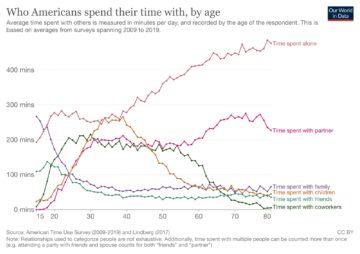Peter Attia in peterattiamd.com:
 I recently shared a graph on Instagram representing whom we spend time with across our lifetime, collected from 2009 to 2019 as part of the American Time Use Survey (Figure 1). For the most part, the numbers make intuitive sense. The amount of time we spend with our coworkers starts dropping in our mid-fifties as we begin to retire, and time with partners rises concurrently. Time spent with children spikes during the typical child-bearing years of our twenties and thirties and falls again as we reach the “empty nest” stage.
I recently shared a graph on Instagram representing whom we spend time with across our lifetime, collected from 2009 to 2019 as part of the American Time Use Survey (Figure 1). For the most part, the numbers make intuitive sense. The amount of time we spend with our coworkers starts dropping in our mid-fifties as we begin to retire, and time with partners rises concurrently. Time spent with children spikes during the typical child-bearing years of our twenties and thirties and falls again as we reach the “empty nest” stage.
Figure 1: Who Americans spend their time with, by age.
These data demonstrate that most of us enjoy a diversity of social connections daily, and yet, throughout virtually all of our lifespan, we spend more time alone than with any given relationship. Especially eye-catching is the rapid increase in time spent alone after the age of forty, and beyond our early sixties, we spend, on average, more than seven waking hours alone.
Guaranteed loneliness?
The same article, published by Our World in Data, interestingly shows that the percentage of Americans living alone across all age groups has been increasing throughout history, as shown in Figure 2 (one exception being a recent decline in the age 75 group, though this is likely an artifact of increased life expectancy). In just the past half-century, the proportion of people living alone has almost doubled. In fact, more than 40% of people over the age of 89 live alone. So not only do we spend more time alone as we age, we also spend more time alone than our historical counterparts at all ages. These combined trends raise the question: are we growing lonely?
Despite these statistics, time spent alone does not reflect a loss of meaningful social connection and does not predict loneliness.
More here.
